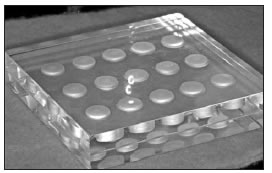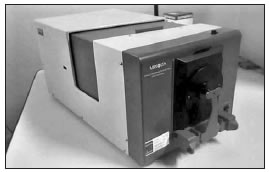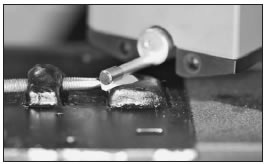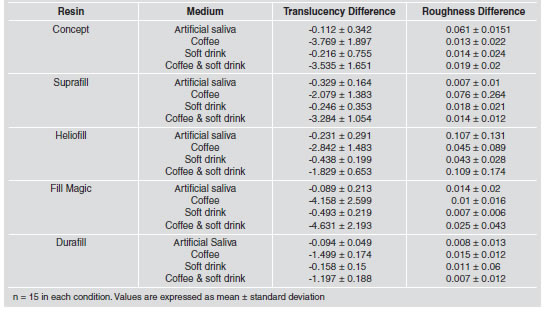Serviços Personalizados
Journal
Artigo
Indicadores
-
 Citado por SciELO
Citado por SciELO
Links relacionados
-
 Similares em
SciELO
Similares em
SciELO
Compartilhar
Acta Odontológica Latinoamericana
versão On-line ISSN 1852-4834
Acta odontol. latinoam. vol.24 no.1 Buenos Aires abr. 2011
ARTÍCULOS ORIGINALES
Surface roughness and translucency of resin composites after immersion in coffee and soft drink
Cresus V. Depes de Gouvea, Luciane M. Bedran, Márcia Aguiar de Faria, Neli Cunha-Ferreira
Department of Dental Prosthodontics, Fluminense Federal University, School of Dentistry, Rio de Janeiro, Brazil.
CORRESPONDENCE Neli Cunha-Ferreira Rua da Matriz 36, apartamento 301 Botafogo, Rio de Janeiro Brasil Cep 22260 100
ABSTRACT
The aim of this study was to evaluate the in vitro changes in color and surface roughness of different composite resins when subjected to cycles of immersion in three coloring solutions: coffee, soft drink, and coffee plus soft drink. Sixty test specimens were made of each material, all in shade A3. Translucency and initial roughness measurements were taken by spectrophotometer and roughness meter. Then the samples were submitted to three cycles per day of exposure to potentially coloring solutions for a period of 15 days. Final roughness and translucency measurements were taken, the mean and standard deviation calculated for each resin and each variable. Data were initially analyzed by the one away ANOVA test, which showed significant differences between groups (p <0.05). Subsequently the post hoc and Tukey tests were performed with level of significance of 0.05. The results showed that the coloring substances altered translucency and surface roughness. DURAFILL resin immersed in the soft drink (M3) was the least pigmented, while CONCEPT resin immersed in the coffee (M2) showed the the least loss of surface smoothness. The Spearman and Pearson coefficients were 0.38 and 0.04 respectively, signifying that there is no correlation between roughness and translucency.
Key words: Composite resins; Translucency; Surface roughness.
RESUMO
Rugosidade superficial e translucidez de resinas compostas após imersão em café e refrigerante
O objetivo do trabalho foi avaliar, in vitro a alteracao de cor e rugosidade superficial de cinco resinas compostas, quando submetidas a ciclos de imersao em tres solucoes pigmentantes, cafe; refrigerante; cafe e refrigerante para tal objetivo, sessenta corpos de prova foram confeccionados de cada material, todas na cor A3. Medicoes de translucidez e de rugosidade iniciais foram tomadas, por espectofotometro e rugosimetro. Em seguida as amostras foram expostas as solucoes potencialmente corantes, em tres ciclos diarios por um periodo de 15 dias. Afericoes finais de rugosidade e translucidez foram tomadas, a media e o desvio padrao computados para cada resina e com cada variante. Os dados foram analisados inicialmente pelo teste one away ANOVA, que constatou diferenca significativa entre os grupos p< 0,05. Posteriormente teste post hoc foi utilizado e ensaios de Tukey com 0,05 de significancia. Apos a analise dos resultados constatamos que as substancias potencialmente corantes alteram a translucidez e rugosidade superficial, que a resina DURAFILL no meio refrigerante (M3) foi a que menos pigmentou. E a resina CONCEPT no meio cafe ( M2) foi a que apresentou a menor perda de rugosidade superficial. Resultados para o Coeficiente de Spearman de 0.38 e de Pearson de 0,04, foram obtidos, significando que nao ha correlacao entre a rugosidade e a translucidez.
Palavras-chave: Resinas compostas; Translucidez; Rugosidade Superficial.
INTRODUCTION
Esthetic demands have created the need for dentists to have knowledge of color and its 3-dimensional nature, as well as factors that influence its stability. Since Bowen1,2 introduced resin composites to the market in 1963, studies have been conducted with the aim of minimizing dimensional alterations.However, as a result of intrinsic and extrinsic coloring agents, the color stability of esthetic restorative materials is extremely critical, creating the need for replacing restorations.
Some authors3-5 believe that color alteration also occurs due to the weakening of the resin/load bond, resulting in a reduction in the translucency of the material due to the migration of colored products into the resin matrix, promoting change in the restoration color and leading to the need for its subsequent replacement. Other researchers6-9 have observed that the fermentation promoted by some foods, as well as the ingestion of potentially staining substances, such as coffee and soft drinks, lead to staining of the restoration surface within a short time. Authors have observed that tooth brushing and chewing (physical agents) and the oral environment itself (chemical agents) favor the increase in surface roughness due to greater bacterial plaque accumulation, predisposing the patient to periodontal diseases, caries and restoration staining by capturing pigments contained in foods10. The surface microhardness of resin obtained after polymerization is an important physical property with regard to maintaining the color and degree of polymerization11-13. The surface roughness of resins, even after finishing, is due to irregularities in the arrangement of the inorganic particles of the restorative material, easily staining the surfaces by mechanical adsorption3,8. In the specific case of Coca-Cola, unspecific corrosion is promoted over the entire resin surface, causing subsequent leaching on the surface14,15. The bright or matt texture of the surface of a material depends on its smoothness, which may be visually evaluated or numerically tested in vitro, by means of a roughness meter, which allows the surface roughness to be quantified by calculating the Ra, which is the arithmetic mean deviation of the profile; i.e. the higher the value, the rougher the surface16. The aim of this study was to observe the alterations in surface translucency and roughness of five commercial brands of resin composites, when submitted to three daily cycles of exposure to potentially staining solutions, such as coffee and soft drink.
MATERIALS AND METHODS
Five resin composites were selected for this study: CONCEPT (Vigodent- RJ, Brazil); SUPRAFILL (SS White-Madleaze Estate, United Kingdom) HELIOFILL (Vigodent- RJ, Brazil); FILL MAGIC (Vigodent- RJ Brazil) and DURAFILL (Heraeus Kulzer-Hanau, Germany) all in shade A3. Three hundred test specimens were made –60 from each selected resin– using 20 transparent, colorless acrylic plates containing 15 niches per plate, measuring 8 mm in diameter and 2 mm deep. The resin composites were inserted and compacted in the respective niches in single increments. Then the niches were covered with a polyester strip and a glass plate placed over it, so that the resin was limited to the niche, and a very smooth surface was obtained (Fig. 1). The samples were polymerized for 40 seconds, using a light polymerizer Optilight 600 (Gnatus, Ribeirao Preto, Sao Paulo) and excess resin was removed with a scalpel blade. The 300 resin composite test specimens were kept in artificial saliva at 37°C (+/-1/C) for 24 hours. After this period the samples were submitted to initial color readouts by spectrophotometer (Minolta Model CM 3720 D New Jersey USA). The initial roughness measurements were taken after spectrophotometry, using a hand-held roughness meter (Hand-held Roughness Tester TR 200, Peking, China). Four types of immersion mediums were used: artificial saliva (M1), coffee (M2), soft drink (M3), coffee plus soft drink (M4). The test specimens were divided into four groups, with 15 specimens in each group, and stored in artificial saliva. Group 1 remained in artificial saliva (M1), at a temperature of 37°C (+/1°C). Group 2 was submitted to three daily cycles of immersion in coffee (30g of coffee powder/300 ml of water) at a temperature of 55°C (M2), for three minutes. Group 3 was submitted to three daily cycles of immersion in soft drink (Coca Cola), at a temperature of 5°C, for five minutes (M3). Group 4 was subjected to three daily cycles of immersion in coffee at 55°C for three minutes, immediately followed by immersion in the soft drink (Coca Cola) at 5°C for five minutes (M4). Between cycles the test specimens were stored in artificial saliva, in a bacteriological oven at a temperature of 37°C (+/-1°C). The artificial saliva, coffee and soft drink were changed after each cycle. At the end of the 15 days, new measurements were taken in the roughness meter (Hand-held Roughness Tester TR 200, Peking, China- Fig. 2) and spectrophotometer (Minolta Model CM 3720 D New Jersey USA- Fig. 3). To observe and record the color alteration values of the resins studied, the CIE L* a* b* system of color coordinates was used. This system uses three coordinates - L*, a*, b*- to define the colors. Coordinate L* represents luminosity, the variation of color between black (L=0) and white (L=100). Coordinates a* and b* represent the chromatic scale, where the value a* determines the variations between red (+a*) and green (-a*), and the value b*, the variations between yellow (+b*) and blue (-b*). These values were used to obtain the total color alteration of the specimens after they had been submitted to the experimental conditions. These measurements were obtained at the Chemical and Textile Industry Technology Center “SENAI CETIC” (Centro de Tecnologia da Industria Quimica e Textil, Campus Riachuelo, RJ, Brazil). After thermal cycling in the four different solutions (saliva, coffee, soft drink, coffee plus soft drink), the roughness and luminosity variations of all the resins used in this experiment were tabulated and submitted to the one way ANOVA test using the software SPSS v 13.0, (SPSS Chicago, IL).

Fig. 1: Test specimen matrix for obtaining the 15 specimens.

Fig. 2: Measurements being taken with the roughness meter.

Fig. 3: Spectrophotometer (Minolta Model CM 3720 D, New Jersey, USA).
RESULTS
When the initial and final roughness and translucency measurements had been obtained, mean and standard deviation were calculated for each resin and each variable. The data were initially analyzed by the one way ANOVA test, which showed significant differences among the groups (p<0.05). Afterwards, the Tukey test at a significance level of 0.05 showed that the most significant translucency and roughness alterations occurred in the resins. The data of this in vitro experiment showed that immersion in soft drink and coffee reduced the translucency and increased the roughness of the studied materials. Spearman and Pearson Coefficients of 0.38 and 0.04 respectively were obtained, signifying that there was no correlation between roughness and translucency. By evaluating the means contained in Table 1 it was observed that all the resins showed the least loss of translucency when exposed to the soft drink medium (M3). DURAFILL resin in the soft drink medium (M3) was the least pigmented, and CONCEPT resin in the coffee medium (M2) showed the the least loss of surface smoothness.
Table 1: Translucency and Roughness Differences.

DISCUSSION
Our research showed that there are alterations in the translucency and roughness of resin composites when they are in contact with potentially staining substances such as coffee and soft drink, and it would seem possible to make this correlation between the type and quantity of load contained in the resin composites. Composites are influenced by the size, type and volume of load particles, and by the proportion in which this load is adhered to the resinous matrix17- 19. Dinelli et al6,20 observed staining of esthetic materials caused by solutions of nicotine, coffee, wine and Coca-Cola, demonstrating that the translucency of the material is affected in such a way that the more pigmentation there is, the more opaque it will be. With regard to this factor, there are various controversial opinions among authors, with Minello8 reporting that wine has greater staining potential. On the other hand, other authors1,21 report that coffee stains more than wine. Other researchers22-24 exposed samples of esthetic restorative materials to the following beverages: red wine (pH 3.7), coffee (pH 5.01) and tea (pH 5.38), and found that coffee and tea promoted more significant surface alterations than wine, even though wine has a lower pH. Coffee caused severe surface staining, which may be associated with an increase in surface roughness due to the solution having an acid pH of approximately 5.01, and a correlation can be made between the type and quantity of load and the capacity of coffee to dissolve at a temperature of 55o. There was a reduction in the surface roughness of the test specimens submitted to the soft drink solution (Coca-Cola), which has a low pH of about 2.7, also attributed to the degradation process of the organic matrix of the composite. Other elements studied by these researchers15,25,26 were dissolved hydrocarbons, which might have acted on the corrosion of the polymers present in the resin, thus causing leaching on the surface after corrosion. In this study it was observed that coffee associated with soft drink was the medium that presented the highest significant indexes of both translucency and roughness. Although there are various studies 6,9,24,27 on the surface roughness of esthetic materials, there is as yet little specific information about the action of beverages on these restorative materials5,28. In this study it was observed that the resins that presented a high index of significance for translucency did not coincide with the high indices of significance for roughness. The resin FILLMAGIC in the coffee and soft drink medium (M4) had the most significant translucency value, while CONCEPT in the soft drink medium (M3) had the most significant roughness value. The results of this study may provide dentists with a clinical view, although further research is necessary for evaluationg the alterations and correlations of the potentially coloring substances and their simultaneous effects on translucency and surface smoothness of resins, not only qualitatively, but also quantitatively, in order to enable comparison of these findings.
ACKNOWLEDGEMENTS
The Authors would like to thank the Chemical and Textile Industry Technology Center “SENAI CETIC” (Centro de Tecnologia da Industria Quimica e Textil, Campus Riachuelo, RJ, Brazil) for allowing the use of the spectrophotometer and the support of specialized technicians. They would also like to thank the Applied Biotechnology Laboratory “LABA-UFF”, (“Laboratorio de Biotecnologia Aplicada da Universidade Federal Fluminense”) for their help in developing and performing the statistics, through the work of Prof. Waldimir Carvalho; the Master’s Course students Vinicius Ferreira and Fernanda Nunes, and the technician Andre.
1. Bowen R L. Properties of a silica-reinforced polymer for dental restorations. J Am Dent Assoc 1963; 66:57-62. [ Links ]
2. Pereira SK, Muller AA, Boratto AC, Veiga PM.Evaluation of composite resin color alteration in contact with staining solutions. Rev Ci Biol Saude 2003;1:13-19. [ Links ]
3. Mckenzie AM, Linden RWA, Nickolson JW. The effect of Coca-Cola and fruit juices on the surface hardness of glassionomers and compomers. J Oral Rehabil 2004; 31:1046-52. [ Links ]
4. Pimenta IC, Lovadino JR, Pimenta LAF, Paulillo LAMS, Liporoni PCS. Staining of glass-ionomer cements by two disclosing agents. Rev ABO Nac 1997;5:110-112 [ Links ]
5. Sarret DC, Colleti DP, Pelisse AR. The effects of alcoholic beverages on composite wear. Dent Mater 2000;16:62-67. [ Links ]
6. Dinelli W, Candido MSM, Catirse ABCE. Effects of cigarretes smoking on the esthetical of translucid restauration materials. Rev Assoc Paul Cir Dent 1996;50:121-124. [ Links ]
7. Jaeger F, Pozzobon RT, Souza NC. Evaluation of surface roughness of one composite resin. Rev Inst Cienc Saude 2005; 23:115-119. [ Links ]
8. Minelli CJ, Chaves PHF, Silva EM. Modification of colour composite resins. Part I. Influence of coffee, tea and wine solutions. Rev Odontol Univ Sao Paulo 1998; 2:143-147. [ Links ]
9. Science of Dental Materials. Phillips RW. Skinner EW. 1991. Ed. Guanabara Koogan. [ Links ]
10. Cooley RL, Barkmeier WW, Matis BA, Siok JF. Staining of posterior resins restorative materials. Quintessence Int 1987;18:823-827. [ Links ]
11. Clareamento Dental. Etiologia das alteracoes de cor. Baratiere LN, Monteiro JS, Andrada MAC, Vieira LCC 1996 Quintessence. [ Links ]
12. Barghi N, Berry T, Hatton NC. Evaluating Intensity output of curing lights in private dental offices. J Am Dent Assoc 1994;125:992-996. [ Links ]
13. Luce MS, Campbell CF. Stain potential of four microfilled composites. J Prosthet Dent 1988; 60:151-154 [ Links ]
14. Souza NC, Pozzobon RT, Suzin AH et al. Evaluation of surface roughness of one composite resin. RGO 2005; 53:71-74. [ Links ]
15. Principios de Ciencias dos Materiais. Propriedades quimicas. Van Vlack LH. 1970. Ed. Edgard Blucher. [ Links ]
16. Introduction to Dental Materials. Resin composites and polyacid-modified resin composites. Van Noort, R. 2 Ed. 2004. Artmed [ Links ]
17. Restorative Dental Materials. Craig R G, Power JM. 2004. Ed. Santos. [ Links ]
18. Dilascio MLC, Prado MAR, D’azevedo MTFS. Surface wear and roughnes of composite resins. Rev Salusvita 2005;24:275-283.
19. Miranda CB, Pagani C, Bottino MC, Benetti AR. A comparison of microhardness of indirect composite restorative materials. J Appl Oral Sci 2003;11:157-161. [ Links ]
20. Dinelli W, Machado MS, Andrade MF, Lofredo LCM. Dye retention influence in the composite resins translucence. Effect of materials, time and immersion ways. Rev ABO Nac 1995; 2:422-426. [ Links ]
21. Chan KC, Fuller JL, Hormati AA. The ability of foods to stain two composite resins. J Prosthet Dent 1980; 43:542- 545. [ Links ]
22. Bagheri R, Burrow MF, Tyas MJ. Surface characteristics of aesthetic restorative materials – an SEM study. J Oral Rehabil 2007; 34:68-76.
23. Wongkhantee S, Patanapiradej V, Maneenut C, Tantbirojn D. Effect of acidic food and drinks on surface hardness of enamel, dentine, and tooth-coloured filling materials. J Dent 2006; 34:214–220.
24. Gasparetto A,Tesmann IPB.Utilization of spectrophotometry to evaluate color alteration in composite resin. Rev Odontol UNESP 1995; 24:235-240. [ Links ]
25. Lima AL, Valenca AMG, Lima SJG, Alexandria AKF, Claudino LV, Silva NB. In vitro study of the action of coconut water and sugar cane broth on aesthetic restorations surfaces. Pesq Bras Odontoped Clin Integr 2007; 7:43-50. [ Links ]
26. Mondelli RFL, Mauad CSP, Marsola FP, Franco EB, Ishikiriama A, Navarro MFL, Mondelli J. Comparative evaluation of composite resins regarding abrasion resistance. Rev Assoc Paul Cir Dent. 2003; 57:439-442. [ Links ]
27. Santos LA, Turbino ML, Youssef MN, Matson E. Microhardness of composite resins: effect of photocuring units and polymerization periods in different depths. Pesq Odontol Bras 2000;14:65-70. [ Links ]
28. Menezes CC, Namen MF, Sergio PP. Stain in the hybrid composite resins-effects of the polishing agents. Rev Bras Odontol 1999; 56:239-241. [ Links ]














